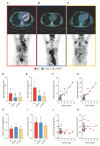Divergent Oxidative Stress in Normal Tissues and Inflammatory Cells in Hodgkin and Non-Hodgkin Lymphoma
- PMID: 37444643
- PMCID: PMC10341255
- DOI: 10.3390/cancers15133533
Divergent Oxidative Stress in Normal Tissues and Inflammatory Cells in Hodgkin and Non-Hodgkin Lymphoma
Abstract
Background: Previous studies reported mitochondrial and endoplasmic reticulum redox stress in peripheral blood mononucleated cells (PBMCs) of treatment-naïve Hodgkin lymphoma (HL) patients. Here, we assessed whether this response also applies to non-HL (NHL) patients, and whether the oxidative damage is a selective feature of PBMCs or, rather, also affects tissues not directly involved in the inflammatory response.
Methods: Isolated PBMCs of 28 HL, 9 diffuse large B cell lymphoma, 8 less aggressive-NHL, and 45 controls underwent flow cytometry to evaluate redox stress and uptake of the glucose analogue 2-NBDG. This analysis was complemented with the assay of malondialdehyde (MDA) levels and enzymatic activity of glucose-6P-dehydrogenase and hexose-6P-dehydrogenase (H6PD). In all lymphoma patients, 18F-fluoro-deoxyglucose uptake was estimated in the myocardium and skeletal muscles.
Results: Mitochondrial reactive oxygen species generation and MDA levels were increased only in HL patients as well as H6PD activity and 2-NBDG uptake. Similarly, myocardial FDG retention was higher in HL than in other groups as opposed to a similar tracer uptake in the skeletal muscle.
Conclusions: Redox stress of PBMCs is more pronounced in HL with respect to both NHL groups. This phenomenon is coherent with an increased activity of H6PD that also extends to the myocardium.
Keywords: 2-NBDG; FDG-PET/CT; endoplasmic reticulum; lymphoma; mitochondria; pentose phosphate pathway; redox stress.
Conflict of interest statement
The authors declare no conflict of interest. The funders had no role in the design of the study; in the collection, analyses, or interpretation of data; in the writing of the manuscript; or in the decision to publish the results.
Figures



References
-
- Marini C., Cossu V., Bauckneht M., Carta S., Lanfranchi F., D’Amico F., Ravera S., Orengo A.M., Ghiggi C., Ballerini F., et al. Mitochondrial Generated Redox Stress Differently Affects the Endoplasmic Reticulum of Circulating Lymphocytes and Monocytes in Treatment-Naïve Hodgkin’s Lymphoma. Antioxidants. 2022;11:762. doi: 10.3390/antiox11040762. - DOI - PMC - PubMed
-
- Senesi S., Csala M., Marcolongo P., Fulceri R., Mandl J., Banhegyi G., Benedetti A. Hexose-6-phosphate dehydrogenase in the endoplasmic reticulum. Biol. Chem. 2010;391:1–8. - PubMed
-
- Marini C., Cossu V., Kumar M., Milanese M., Cortese K., Bruno S., Bellese G., Carta S., Zerbo R.A., Torazza C., et al. The Role of Endoplasmic Reticulum in the Differential Endurance against Redox Stress in Cortical and Spinal Astrocytes from the Newborn SOD1G93A Mouse Model of Amyotrophic Lateral Sclerosis. Antioxidants. 2021;10:1392. - PMC - PubMed

